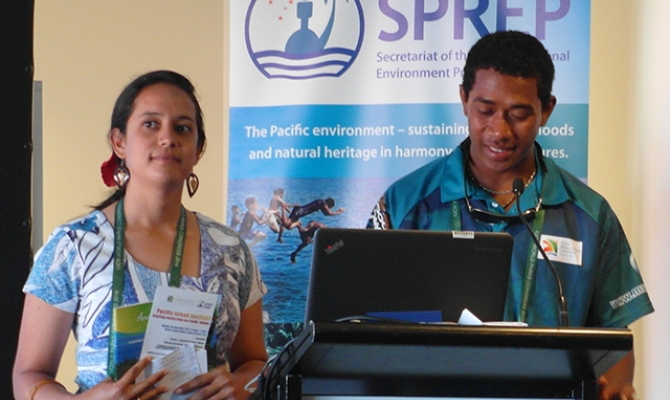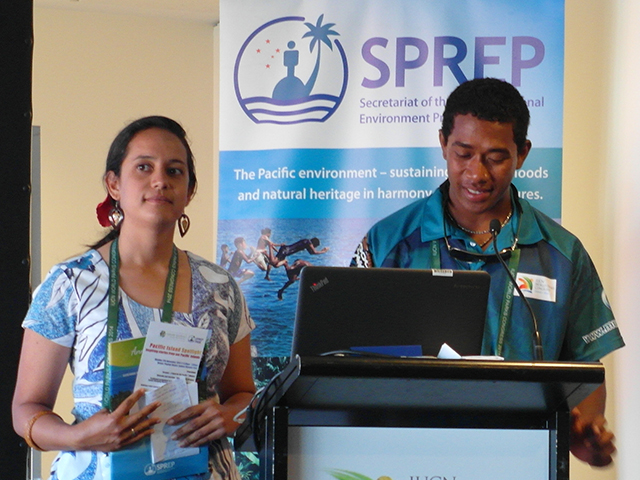
Island and Ocean Ecosystems
Partnerships, regional support, leadership and governance and inspirational stories were the focus of a side event hosted by the Secretariat of the Pacific Regional Environment Programme (SPREP) at the World Parks Congress in Sydney on Monday 17 November.
The scene was set with an opening song entitled "Oceania – a Hymn for the Pacific", featuring different artists from the Pacific. Set to a series of images from across the Pacific islands region, the song was a fitting symbol of the growing recognition of the need for collaborative partnerships and journeying together on "one vaka".
Leadership and action was high on the agenda. Crew members from traditional voyaging canoe, Gaualofa, shared their experiences in voyaging and discussed how the vaka (canoe) might serve as messengers and advocates for environmental action by bringing together young people from around the Pacific. The Gaualofa boasts a mixed crew of Samoans, Tongans, a Fijian and an American.

Kevin Dayonga, member of the Pacific Emerging Environment Leaders' Network (PEEL) also highlighted leadership in environment led by young professionals from around the region. PEEL, initiated by SPREP, is a growing network and seeks to build links with other networks to further its work.
Two presentations from Tonga and Samoa highlighted nationally-led initiatives, which are supported by SPREP and others. Ana Fekau spoke on the recent BIORAP (rapid biodiversity assessment) conducted with SPREP oversight and support, in the Vava'u archipelago of Tonga, which has served to provide a better understanding of the biodiversity in the area. She noted the need for observing protocols and working with communities and leaders to ensure patronage of conservation work.
Talie Foliga of Samoa's Ministry of Natural Resources and Environment discussed the Mount Vaea Restoration Project in Samoa, which will seek to see the eventual removal of rubber trees in favour of native flora. He noted that there is limited knowledge in the islands of appropriate and safe control measures for invasive species and acknowledged the value of external technical assistance when necessary. SPREP is a key player in coordinating much of this work.
The event wrapped up with the launch of the Pacific Islands Protected Area Portal (PIPAP), an internet-based forum ad which will provide a platform for sharing of appropriately distilled information on protected areas for use by practitioners in the Pacific islands. The PIPAP will also establish a forum through which experiences and lessons can be shared between practitioners.
The challenge continues for the region of continuing to work together to value and protect the natural environment and to learn from one another and from beyond our own region.
The scene was set with an opening song entitled "Oceania – a Hymn for the Pacific", featuring different artists from the Pacific. Set to a series of images from across the Pacific islands region, the song was a fitting symbol of the growing recognition of the need for collaborative partnerships and journeying together on "one vaka".
Leadership and action was high on the agenda. Crew members from traditional voyaging canoe, Gaualofa, shared their experiences in voyaging and discussed how the vaka (canoe) might serve as messengers and advocates for environmental action by bringing together young people from around the Pacific. The Gaualofa boasts a mixed crew of Samoans, Tongans, a Fijian and an American.

Pictured above: Gaualofa crew members, Kim Ali'itasi McGuire and Ofa Funaki, speaking at the SPREP side event during the World Parks Congress.
Kevin Dayonga, member of the Pacific Emerging Environment Leaders' Network (PEEL) also highlighted leadership in environment led by young professionals from around the region. PEEL, initiated by SPREP, is a growing network and seeks to build links with other networks to further its work.
Two presentations from Tonga and Samoa highlighted nationally-led initiatives, which are supported by SPREP and others. Ana Fekau spoke on the recent BIORAP (rapid biodiversity assessment) conducted with SPREP oversight and support, in the Vava'u archipelago of Tonga, which has served to provide a better understanding of the biodiversity in the area. She noted the need for observing protocols and working with communities and leaders to ensure patronage of conservation work.
Talie Foliga of Samoa's Ministry of Natural Resources and Environment discussed the Mount Vaea Restoration Project in Samoa, which will seek to see the eventual removal of rubber trees in favour of native flora. He noted that there is limited knowledge in the islands of appropriate and safe control measures for invasive species and acknowledged the value of external technical assistance when necessary. SPREP is a key player in coordinating much of this work.
The event wrapped up with the launch of the Pacific Islands Protected Area Portal (PIPAP), an internet-based forum ad which will provide a platform for sharing of appropriately distilled information on protected areas for use by practitioners in the Pacific islands. The PIPAP will also establish a forum through which experiences and lessons can be shared between practitioners.
The challenge continues for the region of continuing to work together to value and protect the natural environment and to learn from one another and from beyond our own region.